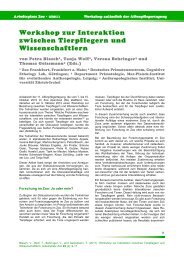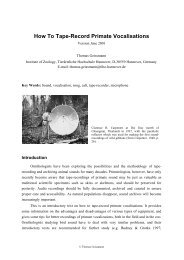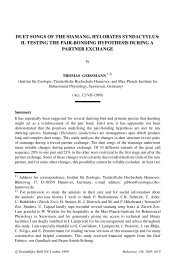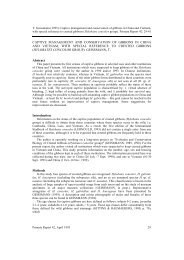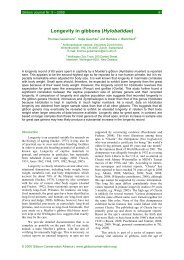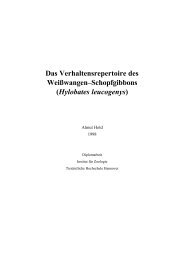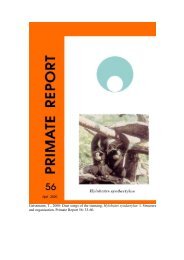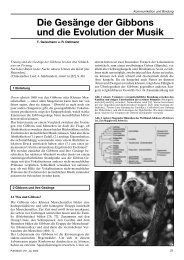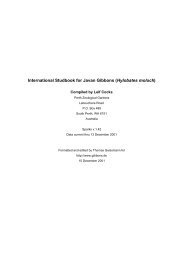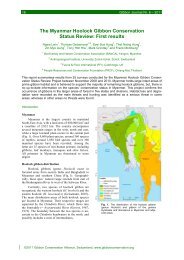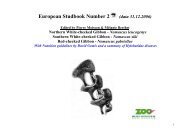The male song of the Javan silvery gibbon (Hylobates moloch)
The male song of the Javan silvery gibbon (Hylobates moloch)
The male song of the Javan silvery gibbon (Hylobates moloch)
- No tags were found...
Create successful ePaper yourself
Turn your PDF publications into a flip-book with our unique Google optimized e-Paper software.
8 T. Geissmann et al. – <strong>The</strong> Male Song <strong>of</strong> <strong>the</strong> <strong>Javan</strong> Silvery Gibbonoccurred infrequently in <strong>the</strong> <strong>song</strong>s <strong>of</strong> <strong>the</strong> Munich<strong>male</strong>, and only one poorly-expressed trill wasfound in <strong>the</strong> <strong>song</strong> <strong>of</strong> <strong>the</strong> Howletts 1 <strong>male</strong>.Frequency <strong>of</strong> note types<strong>The</strong> frequency distributions <strong>of</strong> <strong>the</strong> various notetypes provide first insights into <strong>the</strong> rules by which<strong>male</strong> <strong>silvery</strong> <strong>gibbon</strong>s build up <strong>the</strong>ir <strong>song</strong> bouts. Asshown below, at least two distinct phases canroughly be distinguished in <strong>the</strong> <strong>male</strong> <strong>song</strong> bout: abuild-up or introductory phase and a main phase.In order to monitor changes in <strong>the</strong> proportion <strong>of</strong>notes types in various stages <strong>of</strong> a <strong>male</strong> <strong>song</strong> bout,we divided each <strong>song</strong> bout in 50-note segmentsand determined <strong>the</strong> proportion <strong>of</strong> all note types foreach segment. Not all segments comprise exactly50 notes, because we avoided splitting phrases(described below) into different segments. A andB1 notes were pooled in this part <strong>of</strong> <strong>the</strong> analysis.Figure 3 shows <strong>the</strong> relative frequency <strong>of</strong> allnote types in <strong>the</strong> course <strong>of</strong> <strong>song</strong> bouts <strong>of</strong> our studyanimals. <strong>The</strong> <strong>song</strong> bouts <strong>of</strong> <strong>the</strong> Halimun, Jakarta1, Jakarta 2 and Kalejetan <strong>male</strong>s were nottape-recorded in <strong>the</strong>ir entirety and may lack <strong>the</strong>build-up phase <strong>of</strong> <strong>the</strong> <strong>song</strong> bout. In order to facilitatecomparison, <strong>the</strong> frequency distributions <strong>of</strong> <strong>the</strong>incomplete <strong>song</strong> bouts are shown in separate parts<strong>of</strong> Figure 3.<strong>The</strong> proportion <strong>of</strong> most note types changesmarkedly during <strong>the</strong> <strong>song</strong> bout. <strong>The</strong> amount anddirection <strong>of</strong> <strong>the</strong>se changes differ among notetypes. <strong>The</strong> proportion <strong>of</strong> note types A+B1, forinstance, tends to decrease during <strong>song</strong> bouts.Whereas <strong>the</strong>se two note types make up between37 - 92% <strong>of</strong> <strong>the</strong> first 50 notes in <strong>the</strong> introductoryphase <strong>of</strong> all completely-recorded <strong>song</strong> bouts, <strong>the</strong>proportion decreases during <strong>the</strong> course <strong>of</strong> <strong>the</strong> <strong>song</strong>to levels below 20% and eventually approaches oreven reaches zero, although <strong>the</strong> proportion may goup again towards <strong>the</strong> end <strong>of</strong> <strong>the</strong> <strong>song</strong> (Howletts 3)or fluctuate around 15% during <strong>the</strong> second half <strong>of</strong><strong>the</strong> <strong>song</strong> bout (Howletts 2). In <strong>the</strong> incompletelyrecorded <strong>song</strong> bouts, this trend cannot berecognised clearly, because <strong>the</strong> build-up part ispartly or completely missing. Yet, a decrease in<strong>the</strong> proportions <strong>of</strong> note types A+B1 can also beobserved in each <strong>of</strong> <strong>the</strong> incomplete <strong>song</strong> boutsexcept in <strong>the</strong> Jakarta 2 <strong>male</strong>, which exhibits strongfluctuations around 15% in <strong>the</strong>se note proportionsduring <strong>the</strong> whole tape-recording.<strong>The</strong> proportion <strong>of</strong> note type B2 also tends todecrease somewhat during <strong>the</strong> course <strong>of</strong> <strong>the</strong> <strong>song</strong>bout, but <strong>the</strong> decrease is less pronounced than innote types A+B1, and <strong>the</strong> proportion appears toexhibit strong individual differences. During <strong>the</strong>Table 3. Occurrence <strong>of</strong> note types and some figures in <strong>the</strong> <strong>song</strong>s <strong>of</strong> each study animal, based on all available tape-recordedmaterial. aNote Halimun Howletts 1 Howletts 2 Howletts 3 Jakarta 1 Jakarta 2 Kalejetan c Munichtype bA + + + + + + + +B1 + + + + + + + +B2 + + + + + + + +B3 + + + + + + + +B4 + + + + (+) – + +C1 + + + + + + + +C2 + + + + + + + +C3 + + + + + + + +C4 (+) + (+) + + (+) + +C5 (+) + – – (+) + + –C6 + – + – + + + +C7 + + + + + + + +D – + + + + (+) + (+)E + + + + + + + +FiguretypeTrill f. – (+) – – – + – (+)Variablef.– + + – + + – (+)a Symbols: + = present, (+) = very rare, less than 0.5% <strong>of</strong> <strong>the</strong> <strong>song</strong> notes, – = absentb f. = figurec Absence <strong>of</strong> some note types in this <strong>male</strong> may be due to <strong>the</strong> shortness <strong>of</strong> <strong>the</strong> tape-recorded <strong>song</strong> excerpt (2min 17s, see Table 1).



